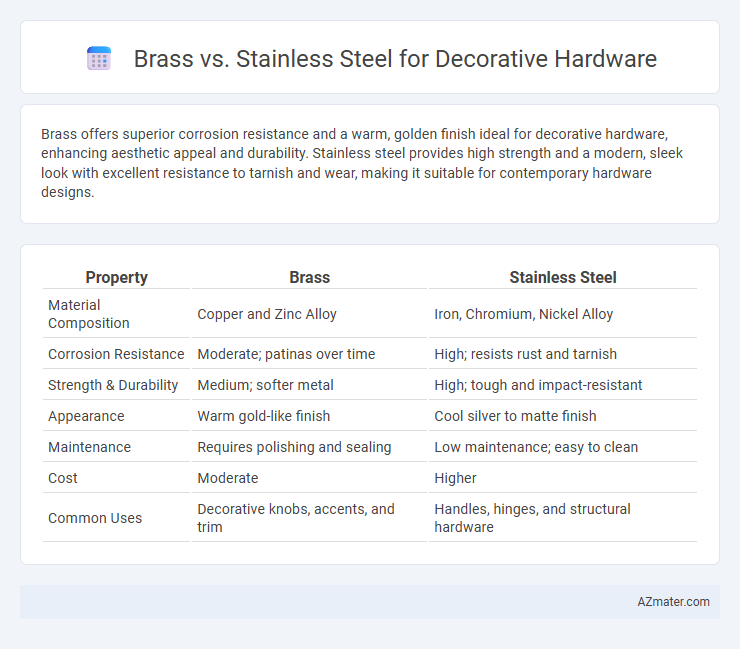Brass offers superior corrosion resistance and a warm, golden finish ideal for decorative hardware, enhancing aesthetic appeal and durability. Stainless steel provides high strength and a modern, sleek look with excellent resistance to tarnish and wear, making it suitable for contemporary hardware designs.
Table of Comparison
| Property | Brass | Stainless Steel |
|---|---|---|
| Material Composition | Copper and Zinc Alloy | Iron, Chromium, Nickel Alloy |
| Corrosion Resistance | Moderate; patinas over time | High; resists rust and tarnish |
| Strength & Durability | Medium; softer metal | High; tough and impact-resistant |
| Appearance | Warm gold-like finish | Cool silver to matte finish |
| Maintenance | Requires polishing and sealing | Low maintenance; easy to clean |
| Cost | Moderate | Higher |
| Common Uses | Decorative knobs, accents, and trim | Handles, hinges, and structural hardware |
Introduction to Decorative Hardware Materials
Brass and stainless steel are two popular materials used in decorative hardware, each offering distinct aesthetic and functional benefits. Brass provides a warm, classic look with natural antimicrobial properties, making it ideal for traditional or vintage-inspired designs. Stainless steel offers superior durability, corrosion resistance, and a sleek, modern appearance, preferred for contemporary or high-traffic applications.
Overview: Brass and Stainless Steel
Brass offers a warm, golden hue with excellent malleability and natural antimicrobial properties, making it a popular choice for decorative hardware requiring intricate designs and classic aesthetics. Stainless steel provides superior durability, corrosion resistance, and a sleek, modern appearance, ideal for high-traffic areas or contemporary styles. Both materials balance functionality and design, with brass excelling in ornamental appeal and stainless steel prioritizing strength and longevity.
Aesthetic Appeal: Color and Finish Differences
Brass hardware offers a warm, golden hue that enhances vintage and classic decor with its natural patina developing over time, while stainless steel provides a sleek, cool-toned silver finish favored for modern, minimalist designs due to its smooth, reflective surface. Brass finishes can range from polished, satin, to antique, providing versatility in achieving a rich, textured look, whereas stainless steel typically has options like brushed or mirror polish that emphasize clean lines and contemporary elegance. Choosing between brass and stainless steel depends on desired aesthetic warmth or cool neutrality, influencing the overall ambiance and style cohesion of decorative elements.
Durability and Longevity Comparison
Brass offers excellent corrosion resistance and can develop a desirable patina over time, enhancing its aesthetic appeal while maintaining durability in decorative hardware applications. Stainless steel provides superior strength and resists rust, scratches, and tarnish, ensuring long-lasting performance in high-moisture or high-traffic environments. Both materials ensure longevity, but stainless steel typically outperforms brass in extreme conditions due to its robust composition and minimal maintenance requirements.
Corrosion Resistance: Brass vs Stainless Steel
Stainless steel offers superior corrosion resistance compared to brass, making it ideal for outdoor and high-moisture environments. Brass, while resistant to tarnish, can develop a patina and is more susceptible to corrosion in harsh or salty conditions. Selecting stainless steel ensures long-lasting durability with minimal maintenance for decorative hardware exposed to the elements.
Maintenance and Cleaning Requirements
Brass decorative hardware requires regular polishing to prevent tarnishing and maintain its warm, golden appearance, often needing specialized metal cleaners and a soft cloth for upkeep. Stainless steel hardware offers superior resistance to corrosion and staining, allowing for easier maintenance with just mild soap and water, making it ideal for high-traffic areas. Choosing between brass and stainless steel depends on the desired aesthetic versus the level of cleaning effort the hardware can endure.
Cost Considerations and Value for Money
Brass decorative hardware typically commands a higher price due to its premium appearance and corrosion resistance, making it a long-term investment for durability and aesthetic appeal. Stainless steel offers a more budget-friendly option with excellent strength and low maintenance requirements, providing great value for money in high-traffic or humid environments. Choosing between brass and stainless steel depends on balancing initial cost constraints with desired longevity and style preferences.
Design Versatility and Application Suitability
Brass offers warm tones and classic elegance, making it ideal for traditional or vintage-inspired decorative hardware, while stainless steel provides a sleek, modern aesthetic suited for contemporary designs. Brass's malleability allows intricate detailing and diverse finishes, enhancing its design versatility, whereas stainless steel excels in durability and resistance to corrosion, making it suitable for high-traffic or moisture-prone environments. Selecting between brass and stainless steel depends on desired style, environmental conditions, and functional requirements of the hardware application.
Environmental Impact and Sustainability
Brass, composed primarily of copper and zinc, is highly recyclable and often sourced from recycled materials, reducing environmental impact and conserving natural resources. Stainless steel, made from iron alloyed with chromium and nickel, also offers excellent recyclability but requires more energy-intensive extraction and processing, contributing to higher carbon emissions. Choosing brass or stainless steel for decorative hardware depends on balancing durability with the sustainability of material sourcing and production practices.
Choosing the Best Material for Your Decorative Hardware
Brass offers a warm, classic aesthetic with excellent corrosion resistance and natural antimicrobial properties, making it ideal for decorative hardware in traditional or vintage settings. Stainless steel provides superior durability, modern appeal, and high resistance to rust and tarnish, suitable for contemporary designs and high-traffic areas. Choosing between brass and stainless steel depends on the desired style, maintenance preferences, and environmental conditions of the installation space.

Infographic: Brass vs Stainless Steel for Decorative Hardware
 azmater.com
azmater.com